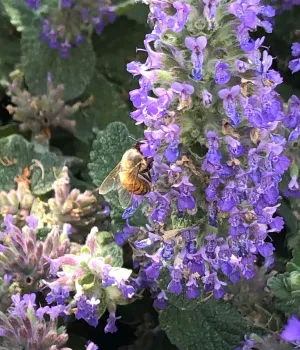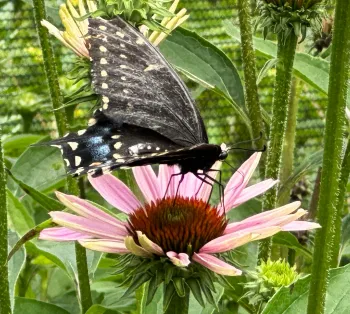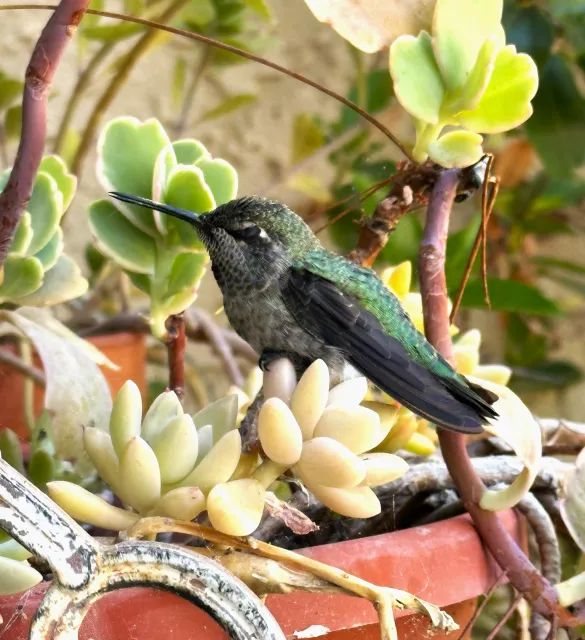Article by Melinda Nestlerode
The world's pollinators are in trouble. Nearly all Earth’s ecosystems depend on the pollination of flowering plants for survival. Seventy to seventy-five percent of all flowering plants require pollination. Pollination is crucial to our food supply, as at least thirty-five percent of food crops require it. Scientists estimate that one out of every three bites of food we eat exists because of pollinators. The following crops (and more) could not exist without pollination: Alfalfa, Almonds, Apples, Avocados, Blackberries, Blueberries, Cacao, Cherries, Coffee, Cranberries, Eggplants, Figs, Grapes, Kiwi, Kumquats, Lemons, Limes, Nectarines, Oranges, Peaches, Pears, Plums, Raspberries, Squash, Strawberries, Vanilla, and Watermelon. By transforming our home gardens into environments that provide food, shelter, and water for these vital creatures, we can help stem the tide of their disappearance.
The number of bees, butterflies, bats, and other pollinators is in decline worldwide. Primary contributing factors for the drop in populations include: loss of habitat due to housing/business development and agriculture; invasive plant species crowding out the native plants pollinators rely on for habitat and food; the irresponsible use of pesticides, herbicides and fungicides, which can kill the animals directly, or destroy plants the pollinators rely upon; climate change – plants may adapt to cooler climates in areas out of sync with their traditional pollinators; parasites and diseases.
Who Are the Pollinators, and How Does Pollination Work?
Pollinators include animals such as bees, birds, butterflies, bats, moths, beetles, and other insects. Pollination occurs incidentally, while the animal is seeking nectar and/or pollen as food for itself or its offspring. Pollen from the male part of a flower (anther) rubs or drops onto a pollinator. In its search for food, the pollinator takes this pollen to another flower, where the pollen sticks to the stigma (the female part of the flower). The fertilized flower later yields fruit and seeds. Pollination can also occur through wind or water, transferring pollen from the anther to the stigma.
Bees – Bees are the workhorses of the world of pollination. We are all aware of honeybees, which are social, live in hives, and make honey. Because they live in beehives, honeybees are transportable and work well for agricultural pollination. Honeybees are not native to the United States; they were brought to this country by European immigrants in the 1600s. For that reason, honeybees are poor at pollinating native plants such as pumpkins, cherries, blueberries, and cranberries, and they are unable to pollinate tomatoes or eggplant. They are also finicky about flying in weather that is not ideal.

There are over 20,000 (non-honeybee) native bees in the world, 4,000 of whom reside in the United States, and 1,600 are native to California. Native bees evolved with native plants and can more efficiently pollinate them. They pollinate seventy-five percent of fruits, nuts, and vegetables in the US, and eighty percent of flowering plants. Native bees forage longer than honeybees and can tolerate cool temperatures and wind.
Most native bees live a solitary lifestyle. Seventy percent nest under the ground, and thirty percent nest in cavities such as hollow stems, rock crevices, or holes made by other insects. Female native bees spend their entire lives building and stocking their nests with provisions, laying individual eggs, and (for cavity nesters) stocking and sealing the eggs into individual cells. They have very short lifespans, some only a few weeks, so it is important to have food sources available for them when they are active, and to select plants that flower during all seasons.
Butterflies – Only adult butterflies are pollinators. In order to attract the adults, our gardens must provide food for their larvae. Butterflies lay their eggs on the leaves of plants, and when they hatch, the larvae are voracious. This can cause the plant to look sad and picked over, so a willingness to accept this is a must. Some butterfly larvae only feed on certain plants. The California Pipevine (Aristolochia californica) is the only plant that pipevine swallowtail larvae will eat, and milkweed (Asclepias fascicularis) is the only plant monarch larvae will eat.

Hummingbirds – Hummingbirds need plants for shelter, shade, nesting, and food. They build their nests from spider webs (consider not knocking down those webs?), cottony leaf hairs, and silky fibers from airborne seeds. Over 160 plants in the US depend on hummingbirds for pollination.

Basic Pollinator Garden Concepts
The single most important element for a pollinator garden is to provide plants that will bloom from late winter (February/March) to early fall (October). While fewer plants bloom in the winter than in the summer, some do exist, such as Ceanothus sp. (CA lilac), Rosmarinus officinalis (rosemary), Lavandula stoechas (Spanish lavender), and Nepeta (catmint).
The ideal pollinator garden contains a minimum of 20 plant types with overlapping flowering seasons planted in 4’ x 4’ patches. Large masses of plants increase flower foraging for pollinator visitors by attracting their attention, and encourage them to forage longer.
It’s important to diversify flower shape and nutritive value in the garden, and to focus on the following six important plant families: Asteraceae (Sunflower); Lamiaceae (Mint); Fabaceae (Pea); Plantaginaceae (Plantain); Rhamnaceae (Buckhorn); Scrophulariaceae (Figwort). Hummingbirds prefer colorful tubular-shaped blossoms; bees select shallower blooms with a landing platform; and butterflies desire shallow tubular flowers with a spur and a wide landing platform.
Use native plants where possible. Many pollinators have developed tightly woven relationships with native plants, and their life cycles are synchronized with the preferred plants' flowering patterns. Native plants are well adapted to our region’s localized climate and soil conditions, and native bees forage on native plants more frequently than on non-native plants. Supplement with non-native plants attractive to pollinators, and add annuals to help keep your garden dynamic with changing colors and flower types.
Provide a water source. Honeybees and butterflies need water to drink, and hummingbirds benefit from misters. Use a shallow dish with a landing surface and place pebbles, stones, or a piece of floating cork or wood to prevent drowning.
Consider leaving a small area of your yard mulch-free, bare soil for our ground-nesting native bees. You may also use pavers set in sand, or provide rock crevices or oak barrels filled with sand or soil. The native bees who nest above ground require stumps, logs, hollow twigs, or grass clumps. You can also provide bee houses set out of the sun and protected from rain. Certain bees also need mud, which they use to seal each egg into its crevice cavity.
Avoid using pesticides. Many garden conditions can be managed with less detrimental methods. Integrated Pest Management (IPM) is the practice of controlling pests using the least environmentally harmful methods, and only resorting to pesticides after biological, cultural, and mechanical methods have failed to remedy the problem. Even then, pesticides are used judiciously and in combination with other approaches for more effective, long-term control.
Specific Plants
The Xerces Society provides area-specific lists of mainly drought-tolerant, native plants with information on bloom period and which pollinators feed from them: https://xerces.org/pollinator-conservation/pollinator-friendly-plant-lists. The California Native Plant Society has a searchable database at: https://calscape.org/search, and the UC Davis Arboretum supplies a list of plants that thrive in our Mediterranean environment, most of which also attract pollinators and beneficial insects: https://arboretum.ucdavis.edu/arboretum-all-stars. The UC Department of Agriculture and Natural Resources Publication 8498 provides a plant list and many useful resources about gardening for pollinators: https://anrcatalog.ucanr.edu/pdf/8498.pdf?fbclid=IwAR2kpBExLWUgJQ1u5nAyjywwRWXd_3D_3Uv-obKgQpnV0UYNyk27SkppsTw.
Gardening to attract pollinators is necessary if we want to keep these crucial animals from becoming extinct. In addition to doing our small part to save the world, we are rewarded with beautiful flowers and the joy of observing bees, birds, butterflies, and other animals cruising through our protective and fertile environment.
Resources:
UCANR Publication 8498 – How to Attract and Maintain Pollinators in Your Garden
http://anrcatalog.ucanr.edu/pdf/8498.pdg
National Park Service - https://www.nps.gov/subjects/pollinators/pollinators-in-trouble.htm
Smithsonian Gardens - https://gardens.si.edu/gardens/pollinator-garden/why-what-when-where-who-how-pollination/
Xerces Society - https://xerces.org/pollinator-conservation/pollinator-friendly-plant-lists

